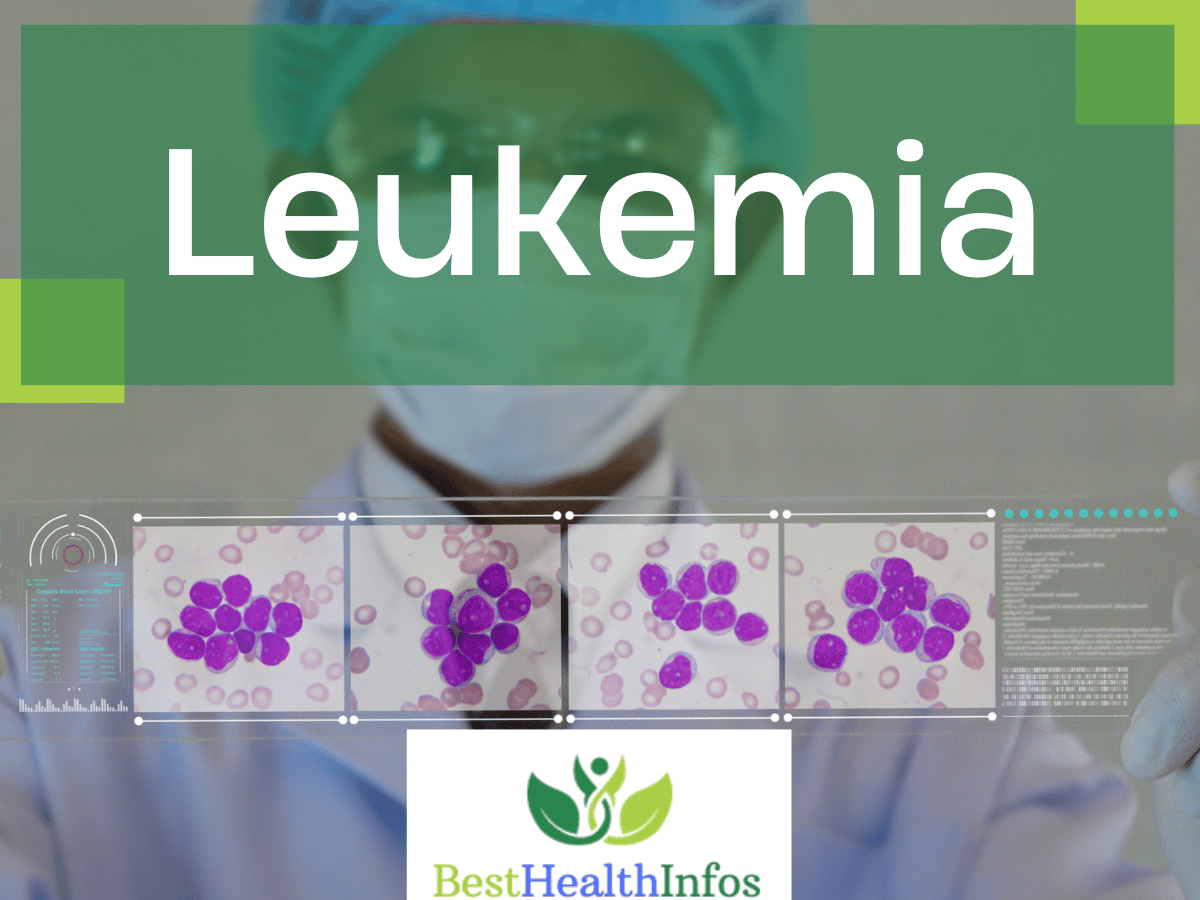Leukemia is a multidimensional spectrum of blood malignancies caused by the complicated workings of the bone marrow and blood-forming tissues that poses a significant challenge to medical research. This comprehensive discussion aims to not only reveal the many varieties of leukemia, but also to delve into the labyrinthine causing causes, minute manifestations of symptoms, sophisticated diagnostic procedures, and the ever-changing landscape of treatment possibilities.
What is Leukemia?
A kind of disease called leukemia affects the bone marrow and blood, making it difficult for the body to naturally make red blood cells. The unregulated development of abnormal white blood cells in this illness compromises the immune system. Different forms of leukemia exist, including acute lymphoblastic leukemia (ALL) and chronic myeloid leukemia (CML).
Leukemia’s precise cause is unclear, however genetic predisposition and chemical exposure have been suggested as potential causes. Among the symptoms include fatigue and easily bruised areas; a bone marrow biopsy and blood testing are required for a diagnosis. Regulating aberrant cell proliferation is the aim of therapeutic modalities such as chemotherapy and stem cell transplantation. The prognosis varies according to the kind and stage of the disease, however continuing research continuously improves results for patients with this difficult blood cancer.
Forms of Leukemia:
The taxonomy of leukemia is as numerous as its clinical manifestations, providing a plethora of forms, each with its own set of features and ramifications.
ALL (Acute Lymphoblastic Leukemia):
- Understanding the unique prevalence of ALL in children (Pediatric Predominance).
- Rapid Progression:
Examining the urgency created by its rapid development.
CLL (Chronic Lymphocytic Leukemia):
- Geriatric Onset:
Examining CLL’s prevalent prevalence among the elderly.
- Unraveling the Subtleties of Asymptomatic Early Stages.
AML (Acute Myeloid Leukemia):
- Myeloid Cell Engagement:
Examining the consequences of AML’s effect on myeloid cells.
- Recognizing the frequency of age variation across various age groups.
CML (Chronic Myeloid Leukemia):
Understanding the slow beginning and probable shift into an acute phase of myeloid growth dynamics.
Signs of leukemia:
A complicated class of blood malignancies, leukemia presents with a range of signs and symptoms that may indicate how the disease is affecting the bone marrow and blood cells. Among these signals are:
- Weariness and Weakness: Persistent weariness and weakness are caused by oxygen transport being disrupted by the leukemia-related loss in red blood cells.
- Frequently Occurring Infections: Leukemia hinders white blood cell activity, which lowers the body’s capacity to successfully fight off infections.
- Unexpected Weight Loss: Leukemia-related metabolic alterations may cause inadvertent weight loss.
- Swollen Lymph Nodes: Often painless, enlarged lymph nodes can be observed in the groin, armpit, or neck and are indicative of aberrant cellular activity.
- Easy Bruising and Bleeding: Low platelets, which are important for blood coagulation, can cause nosebleeds often, extended bleeding from small incisions, and easy bruising.
- Bone Tenderness or Pain: Leukemia cells invading the bone marrow can result in bone tenderness or pain, particularly in the pelvic or long bones.
- Pale Skin: A reduction in red blood cells, or anemia, can result in pallor and a distinctly paler skin tone.
- Night Sweats and Fever: Leukemia impairs the body’s ability to regulate its temperature, which results in ongoing night sweats and fever.
- Headaches and Other Neurological Symptoms: Leukemia can sometimes invade the central nervous system, resulting in symptoms such as headaches, seizures, or other abnormalities of the neural system.
- Pain in the Abdomen: Leukemia cells might gather in the liver or spleen, causing these organs to expand and cause pain in the abdomen.
Those who are suffering these symptoms should get in touch with a doctor right once for a thorough assessment. A medical expert will carry out extensive diagnostic procedures, including as bone marrow biopsy, blood testing, and imaging examinations, to identify the kind and stage of leukemia and create a treatment plan that is suitable. Better results for those with leukemia are mostly dependent on early identification and treatments.
Leukemia Causes:
The etiological tapestry of leukemia displays a complex interaction of genetic, environmental, and viral elements.
Genetic Variables:
Exploring the genetic markers that may make individuals prone to inherited predispositions.
Environmental Aspects:
Toxic Exposures: Investigating the consequences of environmental poisons such as benzene and certain chemotherapeutic drugs.
Radiation:
Radiation Repercussions:
Understanding the medical and occupational repercussions of increased exposure.
Infections caused by viruses:
Viral Associations:
Investigating the complex interactions between viruses such as HTLV-1 and EBV.
Leukemia Symptoms:
The symptomatology of leukemia is a patchwork of subtle yet powerful signals that necessitate a vigilant eye for early identification.
Weakness and fatigue:
Untangling the complicated link between leukemia-induced anemia and chronic weariness.
Infections that occur frequently:
Immunological Compromises:
Investigating the effects of weakened immunological function, which leads to recurring infections.
Unusual Weight Loss:
Metabolic Unraveling:
Deciphering the metabolic changes that contribute to unexpected weight reduction.
Lymph Node Swelling:
Analyzing the clinical significance of enlarged lymph nodes, particularly in certain anatomical locations.
Bruising and bleeding are simple:
Clotting Abnormalities:
Investigating the complexities of faulty blood clotting, which manifests as easy bruising and bleeding.
Leukemia Diagnosis:
Navigating the maze of leukemia diagnosis necessitates a wide range of medical instruments and approaches.
Tests on the blood:
Interpreting the intricacies of a complete blood count (CBC) and a peripheral blood smear.
Biopsy of Bone Marrow:
Understanding the relevance of obtaining bone marrow samples for a thorough assessment is a critical insight.
Imaging Research:
Visual Perspectives:
Deciphering the information offered by X-rays, CT scans, and MRIs.
Cytogenetic Investigation:
Genomic Exploration:
An in-depth examination of chromosomal aberrations in leukemia cells.
Leukemia Treatment Options:
The challenge of controlling this heterogeneous collection of blood malignancies is highlighted by tailoring treatment options to the specific features of each leukemia subtype.
Chemotherapy:
Unpacking the dynamics of drug-based therapies aimed to suppress abnormal cell proliferation.
Radiation Treatment:
Precision Paradigm: Investigating the accuracy of high-energy rays in the targeting and elimination of leukemia cells.
Transplantation of Stem Cells:
Regenerative Methods:
Investigating the complexities of replacing damaged bone marrow with viable stem cells.
Targeted Treatment:
Analyzing the selective targeting of individual molecules involved in cancer progression is known as molecular precision.
Immunotherapy:
Immunological Augmentation is the study of how to boost the body’s immunological response against leukemia cells.
Prognosis and Outlook:
The prognosis of leukemia is a complicated orchestration of elements such as kind, stage, and general patient health. Continuous research improves our understanding, contributing to an improved landscape of leukemia management and survival rates.
Managing Leukemia:
Coping with the many issues of leukemia necessitates a comprehensive strategy that covers the patient’s emotional, psychological, and physical well-being.
Groups of Support:
Community Dynamics:
The importance of community support, in which people share their experiences, ideas, and coping mechanisms.
Counseling:
Professional Counseling:
The function of professional counseling in negotiating the emotional difficulties associated with a leukemia diagnosis.
Survival Rate :
The factors that determine the leukemia survival rate include the kind of leukemia, the age of the patient, the stage of the disease at when it is detected, and the effectiveness of the treatment. Remembering that survival rates are statistical estimates and might not be a trustworthy predictor of a person’s fate is vital.
ALL, or acute lymphoblastic leukemia:
With rates above 90% in children, the overall five-year survival rate for ALL has dramatically improved over time. Adult survival rates are typically lower, however they have been rising as a result of therapy breakthroughs.
Leukemia Chronic Lymphocytic (CLL):
Since CLL is frequently an indolent leukemia (meaning it grows slowly), many patients may not need therapy right away. The five-year survival rate is above 80%, and overall survival rates are strong.
Leukemia Acute Myeloid (AML):
AML’s prognosis is more unpredictable. A patient’s age, genetic mutations, responsiveness to treatment, and other variables might affect their overall five-year survival rate, which is typically between 25 and 30 percent.
Leukemia Chronic Myeloid (CML):
The prognosis for CML has significantly improved, particularly with the introduction of focused treatments such tyrosine kinase inhibitors. Today, more than 90% of CML patients survive for five years.
Speaking with a healthcare provider about survival statistics in the context of each patient’s unique situation is crucial. Personalized treatment approaches lead to better prognoses, and advancements in leukemia research and therapy continue to improve results. Increasing the survival rate of people with leukemia requires early discovery, adequate treatment, and continuous medical advancements. Maintaining the best potential result for patients and controlling the condition also require routine monitoring and follow-up treatment.
Conclusion :
To sum up, this thorough analysis of leukemia covers all the bases, including kinds, causes, symptoms, diagnosis, and available treatments. A complex class of blood malignancies that damage the bone marrow and blood is called leukemia. Because it causes abnormal white blood cells to proliferate uncontrollably, it impairs the immune system. Examined are certain leukemia kinds, such as ALL, CLL, AML, and CML, emphasizing their distinctive characteristics and age-specific frequency.
Discussions are held about symptoms and indicators, diagnostic techniques, and contributing elements including genetics, exposure to the environment, and viral relationships. Options for treatment, including as immunotherapy and chemotherapy, highlight the need for individualized strategies. Counseling, coping mechanisms, and community support systems deal with the emotional difficulties.
Survival rates, which are closely related to the forms of leukemia and how well treatments work, show how far management has come. It is important to keep in mind that survival rates are estimations based on statistics. Personalized conversations with medical professionals provide more insightful information, highlighting the need of early identification and continuous improvements for better leukemia results.
Frequently Asked Questions :
1- What are the five signs of having leukemia?
Leukemia’s early symptoms might include pale complexion, night sweats, headaches, chronic fatigue, recurrent infections, unexplained weight loss, enlarged lymph nodes, easy bruising, and abdominal discomfort. For a complete assessment and early discovery, immediate medical assistance is advised if any of these symptoms continue.
2- How long can a person live with leukemia?
Leukemia life expectancy varies according on the disease kind, age, and response to therapy. Many patients now live for years, and some even achieve a long-term remission or cure because to advancements in therapy. Survival rates are statistical approximations, and individual instances vary. Prognosis is greatly impacted by tailored therapy and early identification.
3- How curable is leukemia?
Treatment options for leukemia differ. Survival rates have increased as a result of therapeutic advancements such as stem cell transplantation, chemotherapy, and targeted medications. Long-term remission or cure is possible in certain situations, especially when early discovery and individualized treatment strategies are used.
4- What is leukemia caused by?
Genetic, environmental, and viral variables are involved in leukemia, yet its exact etiology is unknown. Development of it is influenced by genetic predisposition, exposure to chemicals, radiation, and specific viruses including EBV and HTLV-1.
5- What age does leukemia start?
While leukemia can affect anybody at any age, certain types, like acute lymphoblastic leukemia (ALL), are more common in children, while others, like chronic lymphocytic leukemia (CLL), are more common in older people.



